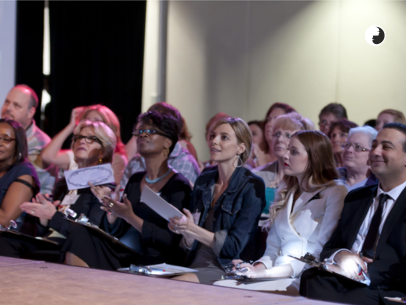8 Hacks To Impress Your Audience During Presentations
Does the idea of an audience make you anxious? Do you feel that it would be great if you could know what your audience would like, what they feel and what they are thinking about as you present so that you could give them the best experience and help them understand in the best possible manner, all while giving your business presentation? Would you like to know the secrets to leaving your audience super impressed with you? Then here are a few ways to get you started.
TIP 1. AUDIENCE ANALYSIS:
As a presenter, you know you have to be prepared with your content and how to present it. But do you know you need to also be prepared for your audience? There are different types of audiences and you can analyze them prior to your presentation in order to be able to know what to expect from them. Doing some homework about the demographics or psychographics of your audience is the key to get you started on audience analysis.

TIP 2. SITUATION PREPS:

After knowing the audience comes the next step which is are you prepared for different situations. For instance, is the occasion going to be highly formal or informal or somewhere in between? Will this mean you need to come across as formal, or dominant or as an expert in your field, or do you need to relax, be more energetic, or perhaps put on your funny cap? Being mentally prepared for these situations and also being aware of how to best use nonverbal communication to your advantage in these situations can help you be more prepared to face your audience. And the more prepared you will be, the easier it will be to handle the moment of finally facing your audience.
TIP 3. CREATING A SPARK:
We all know how good a presenter Tony Robbins is but do you what are the ways that he uses for creating a spark with his audience? It is one thing to be standing on the stage as a presenter, and another to involve your audience along with you in your delivery so that they do not take on another “side” rather they are with you when you present. When you are prepping yourself for what style to adopt, don’t forget to give some thought of how you will want your audience to be a part of the experience. Do you want them to participate? Do you want to break ice with them first? Do you think they need to interact among themselves?

What can you do so that they can feel what you are saying – can you add some sound and graphics effects, use good expressions when you speak? The single biggest challenge of a presentation is how you can transform it from being a monolog to a gripping experience without being overly dramatic.
TIP 4. AUDIENCE REACTION:
Audience doesn’t play a passive role when it comes to presentations. While they might not be directly speaking to you, their expressions, their energy or boredom soon transpires to you, the speaker. The question is, are you able to observe the different reactions that the audience gives while you are presenting? Secondly, can you successfully manage to change your presentation style depending on their reactions? There are different ways to observe reactions of the audience and you can tweak your presentation style accordingly. Again this comes with practice.

So the next time you come home feeling you could not connect with your audience, try and play back in your mind what moments were there when you felt you were losing the connection with your audience and what you could possibly have done about it. So that the next time a similar situation crops up, you can try out the strategy. If your audience is bored, can you create some excitement without stepping out of your personality? If your audience is showing resistance, can you think of ways to open up and get back to the topic once you see the resistance melting down a bit? Being observant is the key here.
TIP 5. ENGAGING SENSES:
An imperative way of adjusting your style as a presenter is to engage them through different senses. Arnab Goswami is an Indian presenter who knows how important it is to engage not just the visual sense of the audience but also the auditory ones. Think of the other senses as well. Can you give your audience a sense of touch and feel of your product and service? Can you evoke emotions with the use of their olfactory sensations? These are all ways of nonverbally connecting with your audience. If your business presentation is going to be at your venue, tweaking these senses is going to be easier than when you need to step into your client’s office to make your presentation. But the use of a good presentation design, props and other activities can help you achieve this.

TIP 6. TACKLING Q&A:

A tricky situation a presenter has to face is during the Q&A round. You might be well prepared for the presentation but Q&A may not be a pleasant experience for all of us, especially if the audience is demanding, or the solution that you are proposing is not truly a win-win for all. While answering, do you focus on the person who has asked the question? Do observe their body language to know how you might need to tweak your answer so that they are receptive and positive? Observe how Jordan Peterson uses effective body language during Q&A.
TIP 7. DEALING WITH NEGATIVE RESPONSES:
One part is answering questions, another essential component is what could be done when there are negative responses. See how Elon Musk the business magnate reacts to negative responses through his body language. Sometimes it may work and sometimes it doesn’t. If you are observant of how your audience is reacting when you respond, it will give you hints of whether you need to explain further, catch an influencer and get them on your side, leave some topic for a later date and so on. If you see your audience closing down or stop responding to your content, you need to become alert.
TIP 8. HANDLING GROUPS:
A tricky situation a presenter has to face is during the Q&A round. You might be well prepared for the presentation but Q&A may not be a pleasant experience for all of us, especially if the audience is demanding, or the solution that you are proposing is not truly a win-win for all. While answering, do you focus on the person who has asked the question? Do observe their body language to know how you might need to tweak your answer so that they are receptive and positive? Observe how Jordan Peterson uses effective body language during Q&A.
Humans love existing in groups; can groupism exist in your audience as well? Does it create an impact on you as a presenter? Did you know that if you focus well on how people in the group are behaving, you would be able to locate patterns in their behavior and decipher whether you need to tackle your audience as a group or address them as individuals? If there are groups, do you need these groups to interact with each other so that they become more open to your presentation as a whole? An astute presenter has to be constantly giving thought to these ideas, not just focusing on what they are saying or presenting.
KNOW MORE:
If you would like to know specific techniques on the above tips, how you can decipher exact reactions of your audience, know what different business leaders do in various situations, which tricks work and which don’t, analyze audiences in detail, and so on, don’t forget to check out our online course Mesmerize Audience during Presentations.






















